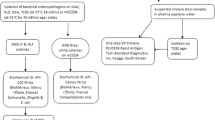Abstract
Babies, on admission into a neonatal ward at the Lagos University Teaching Hospital, had their rectal swab specimens examined bacteriologically and screened for enteric bacterial pathogens over a one-year-period at two-week intervals. It was found that on the average there were 3 (9.68%) enteric bacterial pathogens out of an average of 31 admissions at each screening period. The enteric bacterial pathogens isolated included: non-typhoid salmonellae, which accounted for 55 (80.88%) isolates out of the 68 enteric bacterial pathogens, Salmonella typhi 2.94%, Shigella dysenteriae 2.94%, Shigella flexneri 4.41%, S. boydii 1.47%, S. sonnei 1.47%, Campylobacter jejuni 1.47% and Enteropathogenic Escherichia coli (EPEC) 2.94%. The main clinical conditions associated with those babies in whom the enteric pathogens were isolated included sepsis, prematurity, neonatal jaundice and tetanus.
It is concluded that the enteric bacterial pathogens, even though they were not directly associated with diarrhoeal disease in the newborns in this study, might have contributed to other illnesses like sepsis and meningitis. It is also noteworthy that the enteric bacterial pathogens isolated sporadically from the babies could have been over-looked in view of the fact that it is not conventional to search for enteric bacterial pathogens in babies without diarrhoea on admission. Rectal swab investigations could provide additional information which might be of epidemiological importance in ill neonates in the clinical settings that prevail in developing countries.
Similar content being viewed by others
References
BaineW.B., GangrosaE.J., BennetJ.V., BarkerW.H. (1973): Institutional Salmonellosis. J. Infect. Dis. 128: 357–360.
AlabiS.A., CokerA.O., Dosunmu-OgunbiO., OdugbemiTolu (1986): Biotype and serogroup of Campylobacter isolates from children in Nigeria. J. Clin. Microbiol. 24: 56–858.
CowanS.T. (1974): Cowan and Steel's manual for identification of medical bacteria 2nd ed., Cambridge University press, Cambridge;
EdwardsP.R., EwingW.H. (1972): Identification of Enterobacteriaceae 3rd Ed. Burgess Publishing Co., Minneapolis.
TauxeR.V., HassanL.F., PindeisenK.O., SharrarR.G., BlakeP.A. (1988): Salmonellosis in Nurses: lack of transmission to patients. J. Infect. Dis. 157: 370–373.
ChaturvediP., NarangP., DubeyA.P., MathurN.B. (1987): Salmonella senftenberg epidemic in a neonatal nursery. Indian Pediatr. 24: 199–202.
Author information
Authors and Affiliations
Additional information
Corresponding author.
Rights and permissions
About this article
Cite this article
Odugbemi, T., Egri-Kwaji, M.T.C. Screening of children for enteric bacterial pathogens in the outborn neonatal ward in Lagos, Nigeria. Eur J Epidemiol 7, 427–430 (1991). https://doi.org/10.1007/BF00145009
Issue Date:
DOI: https://doi.org/10.1007/BF00145009




